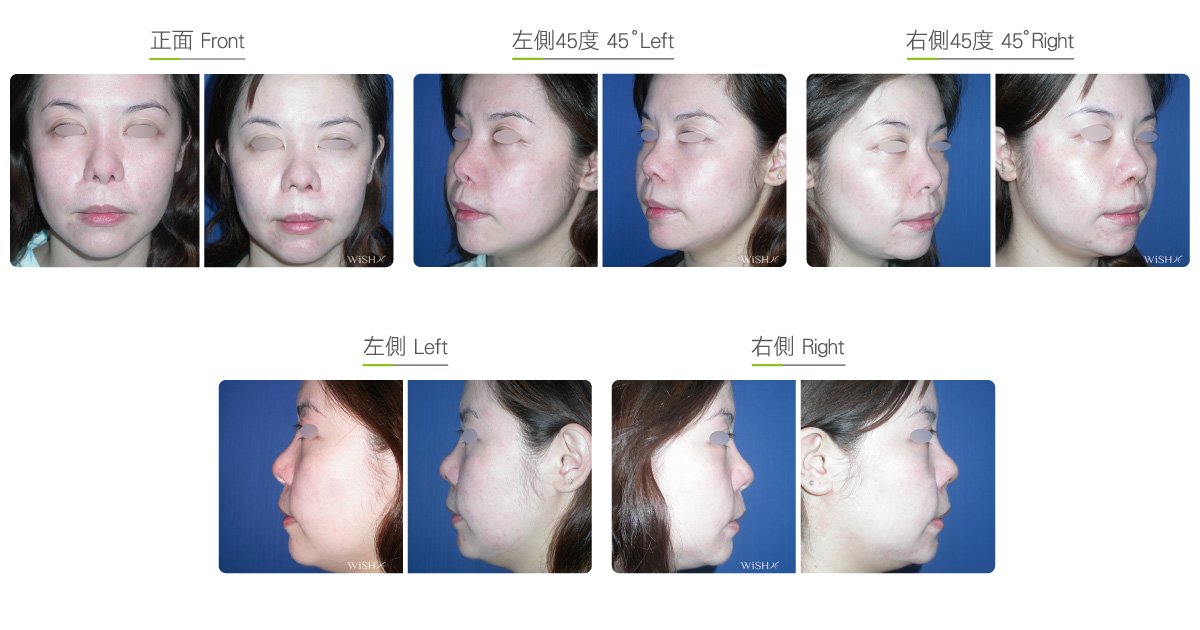Columellar reduction
The nasal columella is the lowest point of the nose and is the primary framework to support the nasal tip. It comprises two flakes of lower lateral (alar) cartilages that meet at the midline, which attaches to the nasal spine of the upper palate at the inferior end and connects with the nasal septum at the back, to provide a better and stable strut at the nasal base. Besides the functional role of stabilizing the nasal tip, the columella determines the esthetics of the nose by its position and length. Aplasia or retraction of the nasal columella makes the nose appear short and lack a marble-shaped supra-tip and makes the horizontal line of the bilateral alar feet lower than the nasal columella, leading to eccentric physiognomy of the nasolabial angle to less than 90°, so surgery requires the transplantation of abundant cartilage to reconstruct the nasal columella and nasal tip angle; on the contrary, hyperplasia of the nasal columellar cartilage elongates or pulls the nasal columella downward to give the connection between the nostrils and nasal columella an appearance of a sea gull wing and result in nostril exposure or a pseudo-upturned nasal tip. The optional treatment is similar to snub nose correction or nasal columellar retraction targeted at reducing and elevating the nasal columellar cartilage.
Nasal columellar reduction is performed to reconstruct the lower lateral (alar) cartilage without the emplacement of any prosthesis or cartilage to decrease the nasolabial angle from an obtuse angle (more than 110°) to the standard angle of less than 110°. A surgical incision is made based on the severity of the patient’s conditions, either inside the bilateral nostrils (closed method) or at the bottom of the nasal columella (open method). After the lower lateral (alar) cartilage at the midline is separated, the partial cartilage is resected; then, the suture between the lower lateral (alar) cartilage and nasal spine is dissected, and the base of the cartilage is posterosuperiorly fixated at the base of the nasal septal cartilage. In this way, the surgery successfully shortens the nasal columella and restores the nasolabial angle to the standard angle of 100° and improves the partially upturned nose or nostril exposure caused by the prominent columella.
Surgical conditions
Duration
- Type of anesthesia: IV sedation + local anesthesia
- Surgical incision: Inside the bilateral nostrils or at the bottom of the nasal columella
- Recovery: 2–3 days
- Removal of stitches: 7 days
General instructions
No food and water on the day of surgery
- Do not smoke for 1 week on the day of operation.
- Avoid smoking and alcohol and impacts to the nasal tip for 3 months postoperatively, and clean the intranasal wound in the morning and evening every day.
- Avoid exposure of the nostrils to dirty water (sea water, swimming pool or sauna water, and hot springs) and close contact with pets and dust mites for 3 months postoperatively.
Ideal candidates
- Patients with nostril exposure as a result of congenital nasal columellar elongation
- Those with visual defects due to an upturned nose from an exceedingly low nasal columella
- Those who are unwilling to undergo overall rhinoplasty or prosthesis implantation to address the upturned nose
Potential complications
- Nasal columellar scar
- Incomplete correction
Surgical advantages
-
It is able to remedy nostril exposure by only limited-area cartilaginous tipasty.
-
There is no need to collect autologous cartilage for elongating the nasal tip.
-
There is no risk of prosthesis implantation.
-
It has a painless and short recovery period.
Surgical drawbacks
-
It is only able to partially correct the upturned nose or nostril exposure.
-
It is unable to modify congenital defects such as a snub nose.
-
The surgical results may be subtle.
-
The probability of reversibility is relatively low.

